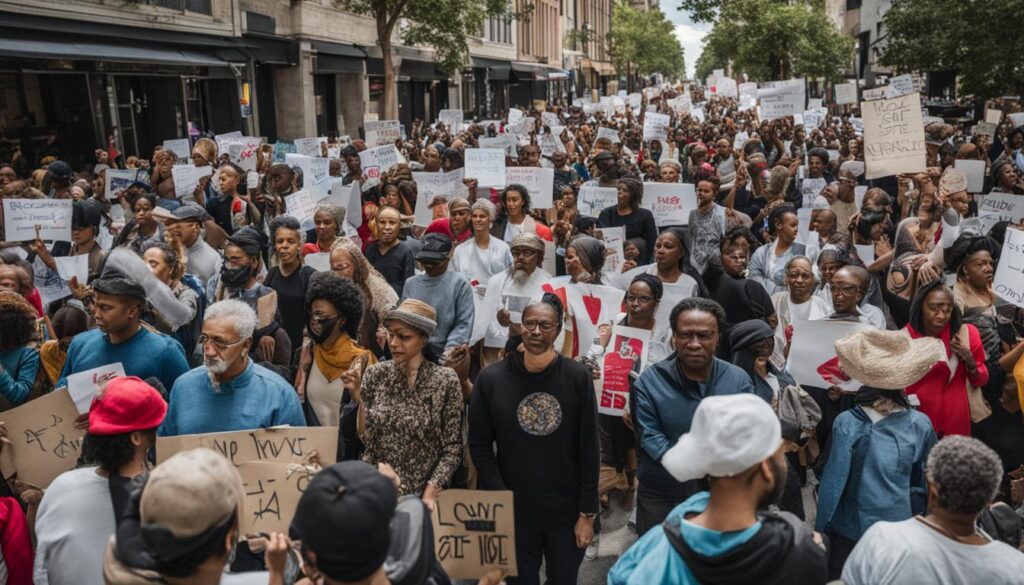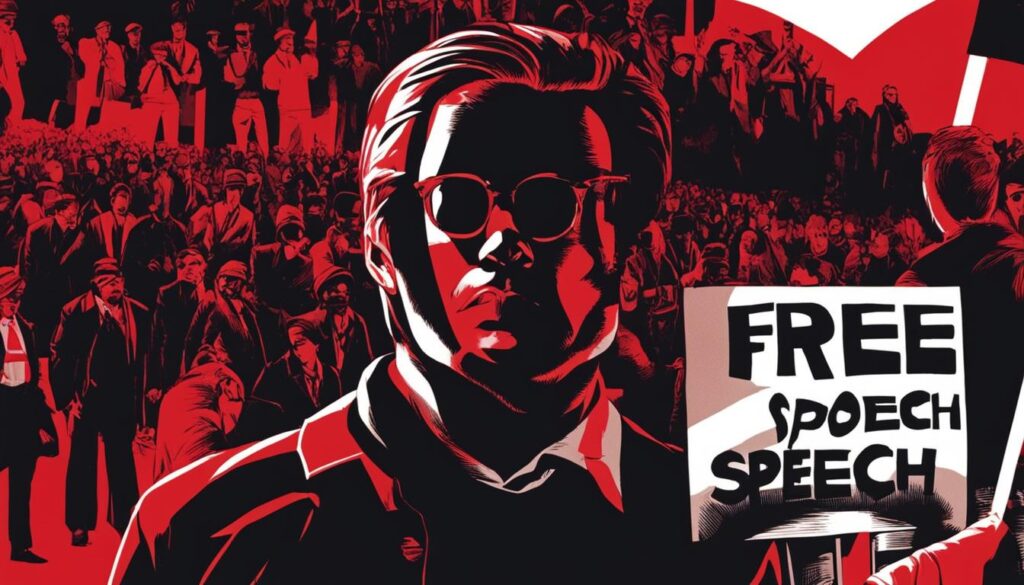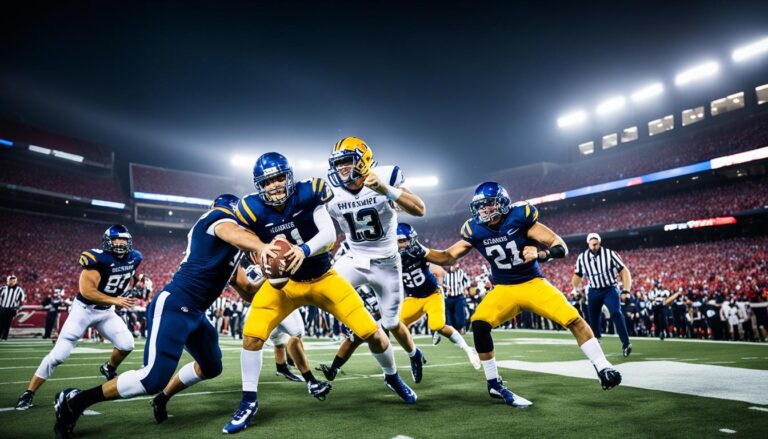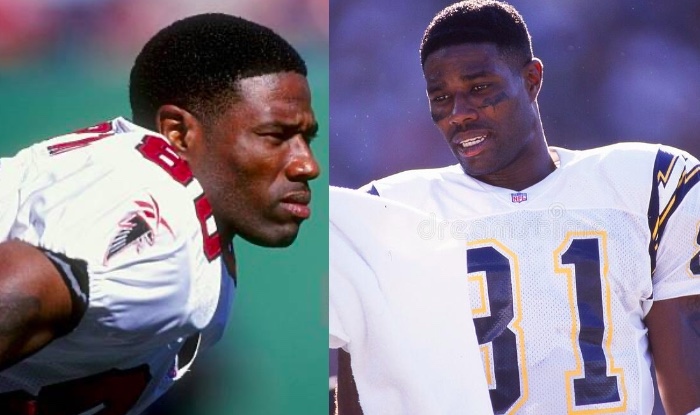The Free Expression Clause is a vital component of the First Amendment of the United States Constitution. It grants individuals the constitutional right to freedom of speech, expression, and the press. Understanding the significance of this clause is crucial to safeguarding our rights and promoting a vibrant democracy.
In this article, we will explore the Free Expression Clause in detail, discussing its scope, limitations, and historical legal precedents. We will examine what forms of speech are protected, the boundaries of political expression, and the fine line between protected and unprotected speech. Additionally, we will delve into symbolic speech and its legal considerations.
By gaining a deeper understanding of the Free Expression Clause, we can better appreciate the extent of our First Amendment rights and the responsibilities that come with exercising them.
Key Takeaways:
- The Free Expression Clause safeguards our constitutional rights to freedom of speech, expression, and the press.
- It protects various forms of speech, including verbal, written, and symbolic.
- While the Free Expression Clause grants significant protection, there are limitations and exceptions.
- Legal precedents help shape the boundaries of free speech and political expression.
- Symbolic speech is subject to specific considerations and restrictions.
Understanding the Free Expression Clause of the First Amendment
The Free Expression Clause, as part of the First Amendment, safeguards individuals’ rights to freedom of speech, expression, and the press. This constitutional protection grants individuals the ability to express themselves freely without interference from the government. It encompasses various forms of speech, including verbal, written, symbolic, and even offensive speech.

However, it is important to note that there are limitations and exceptions to this right. While the First Amendment guarantees freedom of speech and expression, certain types of speech can be restricted under specific circumstances. These limitations exist to balance the right to free speech with other important societal interests, such as public safety, national security, and the protection of individual rights.
What Is Protected Under the Free Expression Clause
Under the Free Expression Clause, individuals have the right to express their opinions, beliefs, and ideas freely, even if these views are controversial or unpopular. Protected speech includes:
- Political speech, including criticism of the government and public officials
- Artistic expression, such as music, literature, and visual arts
- Religious speech, including the practice and promotion of one’s faith
- Symbolic speech, which involves non-verbal forms of expression, such as gestures, clothing, and flags
- Offensive speech, as long as it does not incite immediate violence or pose a direct threat
These forms of protected speech contribute to a robust public discourse and the exchange of ideas critical to a democratic society.
However, it is crucial to understand that the First Amendment does not protect certain types of speech, including:
- Defamation, which involves false statements that harm a person’s reputation
- Obscenity, as determined by community standards
- Incitement to violence or other unlawful actions
- Child pornography
- Hate speech that directly incites discrimination, harassment, or violence against specific individuals or groups
These limitations on speech, implemented through the legal system, aim to prevent harm, protect individual rights, and maintain social order.
| Protected Speech | Unprotected Speech |
|---|---|
| Political speech | Defamation |
| Artistic expression | Obscenity |
| Religious speech | Incitement to violence |
| Symbolic speech | Child pornography |
| Offensive speech | Hate speech |
The Scope and Limitations of the Free Expression Clause
While the Free Expression Clause of the First Amendment protects a wide range of speech and expression, there are certain limitations and exceptions that have been established through historical legal precedents. These legal precedents have shaped the boundaries of free speech and protected political expression, while also recognizing the need for certain restrictions and protections.
Historical Legal Precedents Affecting Free Speech
Throughout history, there have been landmark cases that have set legal precedents for the scope of free speech. One such case is Brandenburg v. Ohio, in which the Supreme Court established the “imminent lawless action” test. According to this test, speech can be restricted if it is likely to incite immediate violence or illegal activity.
Another notable case is United States v. O’Brien, which dealt with the burning of draft cards during the Vietnam War. The Supreme Court held that this act of symbolic speech could be regulated by the government if it furthered an important government interest unrelated to the suppression of speech.
Political Expression and Campaign Contributions
Political expression and campaign contributions have been areas of contention when considering the limits on free speech. The Supreme Court’s decision in Citizens United v. FEC has sparked debate about the influence of money in politics and its impact on free speech rights. The ruling held that campaign contributions by corporations and unions are a form of protected speech under the First Amendment.
The Fine Line: When Free Speech Becomes Unprotected
While the Free Expression Clause protects a broad range of speech, it is important to understand when free speech may become unprotected. Certain types of speech, such as obscenity, defamation, incitement, and fighting words, do not receive the same level of constitutional protection due to their potential harm or disruption to society.
Symbolic Speech and Its Boundaries
Symbolic speech, which includes actions, signs, and symbols that convey a particular message, is another aspect to consider when examining the scope of free expression. The parameters of symbolic speech have been defined through legal precedents, such as the burning of the American flag in Texas v. Johnson. The Supreme Court ruled that this act of symbolic expression was a form of protected speech.

Understanding the scope and limitations of the Free Expression Clause is crucial to navigating the complexities of free speech rights. It is essential to balance the protection of individual liberties with the preservation of societal order and well-being. By examining historical legal precedents and considering the nuances of political expression, unprotected speech, and symbolic speech, we can gain a deeper understanding of the delicate balance between free expression and the legal limitations imposed upon it.
Conclusion
In conclusion, the Free Expression Clause is a fundamental aspect of the First Amendment that ensures the protection of individuals’ First Amendment rights, including freedom of speech, expression, and the press. It serves as a cornerstone of our constitutional framework, safeguarding our democratic values and promoting an open and diverse society.
The Free Expression Clause grants considerable protection to various forms of speech, allowing individuals to express their opinions, ideas, and beliefs without government interference. It encompasses verbal, written, and symbolic speech, and recognizes the importance of unrestricted expression in fostering public discourse and the exchange of ideas.
However, it is crucial to understand that the Free Expression Clause is not absolute. While it provides broad constitutional protection, there are limitations and exceptions that have been established through historical legal precedents. These limitations aim to balance the exercise of free speech with other compelling societal interests, such as public safety, privacy rights, and the prevention of harm.
By understanding the scope and limitations of the Free Expression Clause, we can appreciate the delicate balance between individual rights and societal interests. This knowledge empowers us to participate responsibly in our democratic society, respecting the rights and perspectives of others, while also advocating for the protection and preservation of our constitutional freedoms.
FAQ
What is the Free Expression Clause?
The Free Expression Clause is a crucial component of the First Amendment of the United States Constitution. It protects individuals’ rights to freedom of speech, expression, and the press.
What does the Free Expression Clause protect?
The Free Expression Clause grants individuals the right to express themselves freely without government interference. This includes various forms of speech, such as verbal, written, symbolic, and even offensive speech.
Are there any limitations to the right to free expression?
While the Free Expression Clause protects a wide range of speech, there are certain limitations and exceptions that have been established through historical legal precedents.
What are some examples of limitations on free speech?
Precedents have been set to protect political expression and campaign contributions while also defining when free speech may become unprotected. The legal considerations surrounding symbolic speech have also been explored.
























[…] Free Expression Clause: Your Rights Explained […]